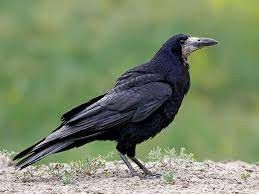The Kennedy Wild Bird Food Guide to the Rook
The rook bird is a familiar sight when exploring the UK countryside and is the most abundant Eurasian bird of the crow family. With its bare, grey-white face, a rook is an extremely sociable bird and it's very rare to see one on its own.
It is usually seen in the countryside and large open fields but they have begun to venture into town parks and villages. They do however steer clear of larger towns and cities.
What does a rook bird look like?
It has black-blue feathers, a greyish-white face and a powerful medium length thick black bill. At 45 centimetres, the rook is similar in size to its cousin, the carrion crow, but an adult rook's thigh feathers are usually shaggy.
(Adult rook on the left & juvenile rook on the right)


A juvenile rook can be easily confused for a crow as it doesn't have the white-grey skin at the base of its bill although it loses these darker feathers after 6 months, revealing the adults signature white-grey skin at the base of the bill
How to identify a rook from a crow
It is said that if you see one rook, then it's more than likely to be a crow and if you see lots of crows, then they're likely to be rooks.
Whilst this is an over-simplification of their differences, rooks are significantly more sociable than crows. However, the most defining difference is the bare grey-white skin around the bill of an adult. Generally speaking, they are less stocky than crows, have a thinner beak and also have a distinctive peak to their crown.
What does a rook sound like?
A rook has a similar birdsong to a crow and can be described as if the rook was saying ñkaah-kaah-kaahî. Whilst doing this, a rook usually fans its tail and bows on each caw.
As rooks are usually found in groups, solitary rooks can often be seen almost ñsingingî to themselves with strange clicks and birdsong notes.
Click here to listen
Where can you spot rooks?
From the same family, the term a 'parliament of crows' can also be used for seeing a collective of rooks. Rooks can be found throughout Britain, Europe, and Asia and are a familiar sight all year round in open fields, the countryside and roadsides feeding on worms and grains.
They are however absent from the far north west of Scotland. The rook bird has started to pop up in small countryside towns and villages especially where there are bird feeders or near to farmland.
It's extremely uncommon to spot a rook in an urban area, but if you do spot one, make sure to log your sighting on our BirdSpotter tool.
Where do rooks nest?
Usually found in the tops of trees, rooks break off branches and twigs from trees to build their nest. Their nests are built in a colony and each nest fits between 3 and 5 eggs.
The end of February and early March is the main nesting season and the eggs are incubated for between 16 and 18 days. During the autumn, rooks put on a spectacular aerial display with the young birds of the summer coming together with unpaired birds from the previous season to form large flocks of rooks.
What do rooks eat?
Rooks usually feed on worms and insect larvae which it picks out from the ground using its thin, strong bill. They also eat grains, small amounts of fruit, acorns, smaller mammals such as voles and even the eggs of ground-nesting birds. In small villages and towns, rooks can be seen feeding on peanut bird feeders and taking scraps away from rubbish bins and the streets in the morning when there aren't many people around.


